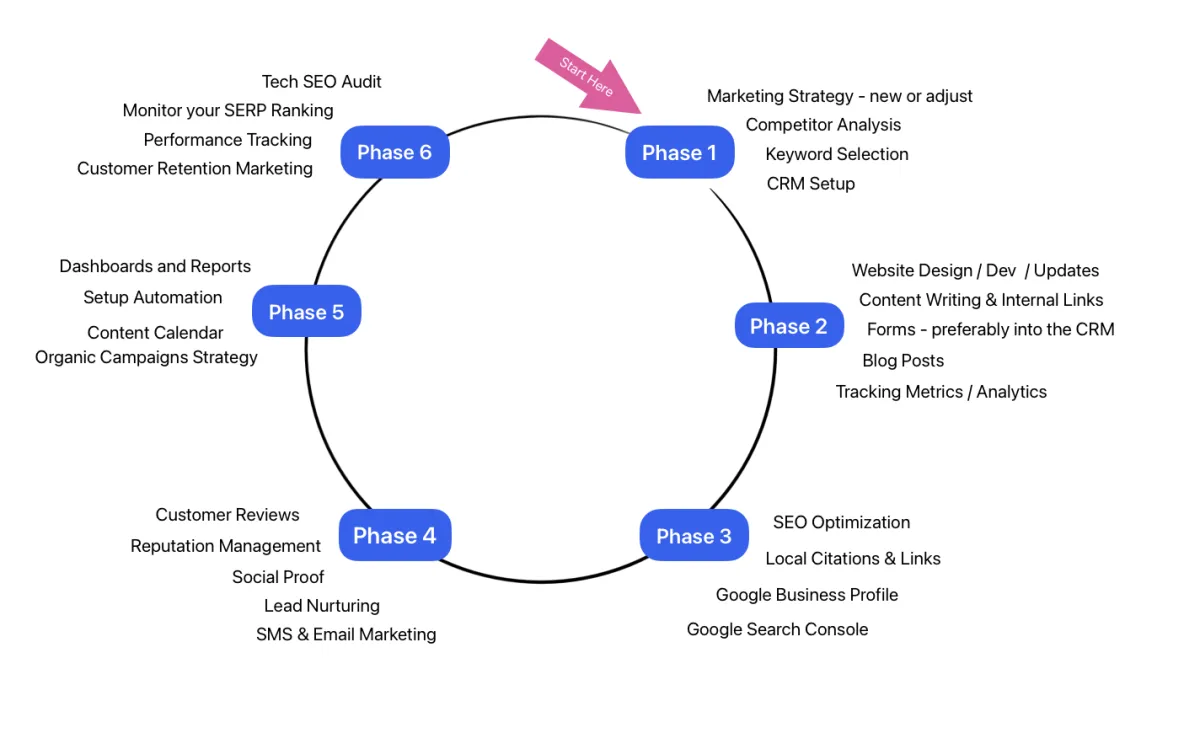Mastering SEO: A Comprehensive Six-Phase Framework for Lasting Digital Success
In the ever-evolving digital landscape, a strategic approach to SEO is crucial for accomplishing an optimized site.
By following the below six phases, you create a structured, organized approach to SEO that not only helps in maintaining focus but also ensures that all elements work harmoniously towards your marketing goals.

This method allows for ongoing optimization and refinement, positioning your brand for sustained success in the competitive digital landscape.
Here’s a breakdown of my six phases to achieve SEO success:
✅ Phase 1:
☑ Marketing Strategy - new or adjust
☑ Competitor Analysis
☑ Keyword Selection
☑ CRM Setup
✅ Phase 2:
☑ Website Design / Development / Updates
☑ Content Writing & Internal Links
☑ Forms - preferably into the CRM
☑ Blog Posts
☑ Tracking Metrics / Analytics
✅ Phase 3:
☑ SEO Optimization
☑ Local Citations & Links
☑ Google Business Profile
☑ Google Search Console
✅ Phase 4:
☑ Customer Reviews
☑ Reputation Management
☑ Social Proof
☑ Lead Nurturing
☑ SMS & Email Marketing
✅ Phase 5:
☑ Dashboards and Reports
☑ Setup Automation
☑ Content Calendar
☑ Organic Campaigns Strategy
✅ Phase 6:
☑ Tech SEO Audit
☑ Monitor your SERP Ranking
☑ Performance Tracking
☑ Customer Retention Marketing
REPEAT - REPEAT - REPEAT
footer-main
Ready for 2025?
SEO is EVOLVING
Those who adapt to “answer engines” and “brand-first thinking” will dominate.
1. SEO is morphing into “AEO” (Answer Engine Optimization)
• Google, ChatGPT, Perplexity, and Claude are becoming answer engines, not search engines.
• Ranking first will matter less than being the source that AI and users trust.
• Authority, clarity, and data structure are the new gods.
Action Step:
•→ Start structuring your content for direct answers: clear H1s, short definitional paragraphs, FAQs, bullet lists.
•→ Think: How would ChatGPT summarize my page? If it can’t easily, you’re losing future exposure.w
2. “Brand” Will Be the New SEO Shortcut
• AI models will mention known brands and default to popular names in responses.
• If you aren’t building brand awareness now, you will get wiped out later, no matter how “good” your on-page SEO is.
Action Step:
•→ Get your name (or your clients’ names) mentioned everywhere: podcasts, guest posts, press, LinkedIn, etc.
•→ Optimize for “entity SEO” — Google and AIs recognize people, companies, and brands.
3. Content Velocity Matters, but Only If It’s Smart
• AI can generate a million blog posts. Humans can’t compete on volume — only on usefulness and expertise.
• Google’s E-E-A-T (Experience, Expertise, Authority, Trustworthiness) matters more in an AI-first world.
Action Step:
•→ Produce fewer but higher authority pieces:
•→ Original research
•→ Expert opinion content
•→ Story-driven insights
•→ Make yourself or your clients “un-copyable” with human experience injected into the content.
4. Video and Audio SEO Will Explode
• AI loves multimodal content (text, audio, video).
• Google’s ranking more YouTube clips inside search.
• OpenAI’s newer models are using video + audio as training material.
Action Step:
•→ Add YouTube videos, podcast audio, or video explanations to every blog.
•→ Optimize titles, captions, transcripts, and metadata aggressively.
5. Data and Tools Are the Moats
• Static info (“What is X?”) is becoming worthless.
• Interactive data (tools, calculators, widgets) will still rank and get cited.
Action Step:
•→ Start building interactive tools around your niches.
(Even basic ones like checklists, ROI calculators, simple quizzes.)
6. Sourcing and Citations Will Matter More
AI models want to cite credible sources. They need signals like:
• .gov, .edu
• Author bios with credentials
• Clear source links and citations.
Action Step:
•→ Always cite credible sources in your blogs.
•→ Build your own citations (get mentioned in trusted directories, media, etc.)
Summary:
SEO → AEO Write for direct, fast answers
Brand SEO → Build brand mentions and authority
Smart Content Only → Publish fewer, smarter, human stories
Video & Audio SEO → Attach videos and podcasts to posts
Tools → Blogs Create interactive tools/widgets
Citations Matter → Link and get linked by credible sources

Facebook
LinkedIn